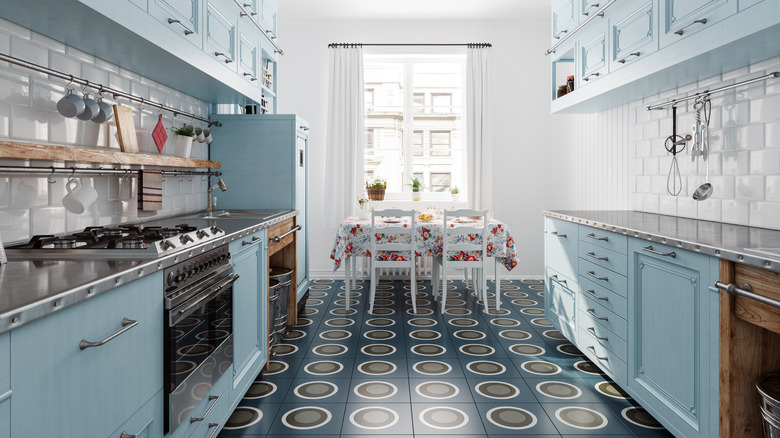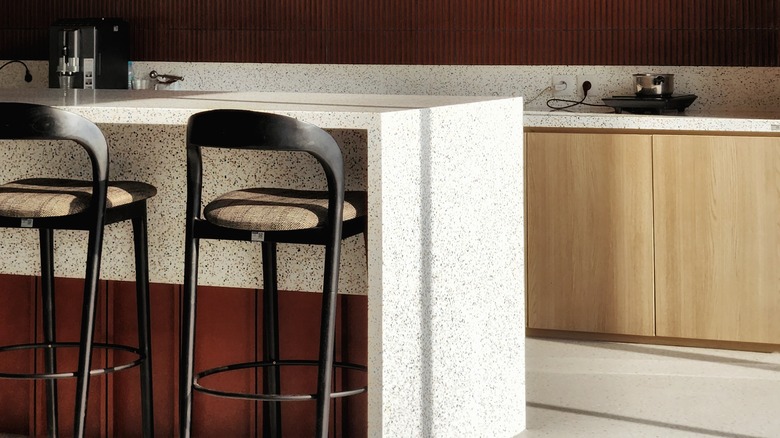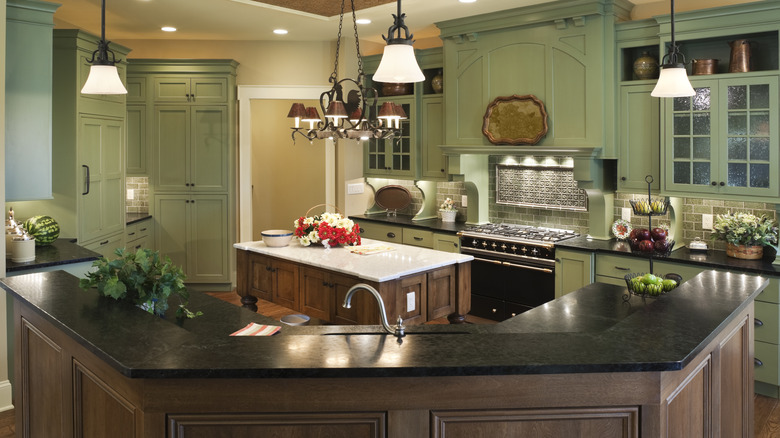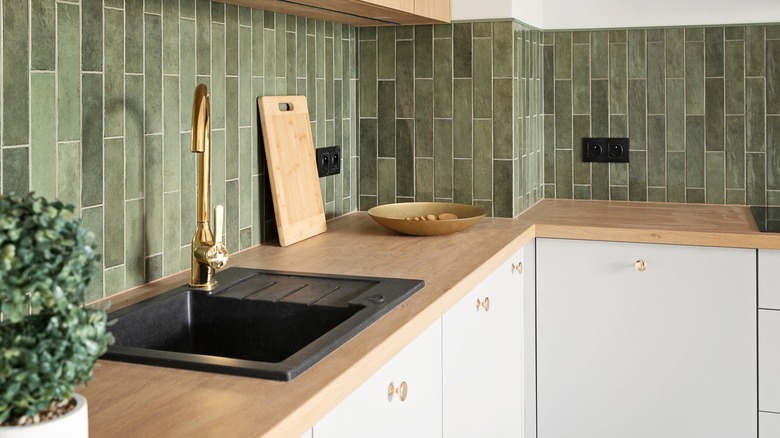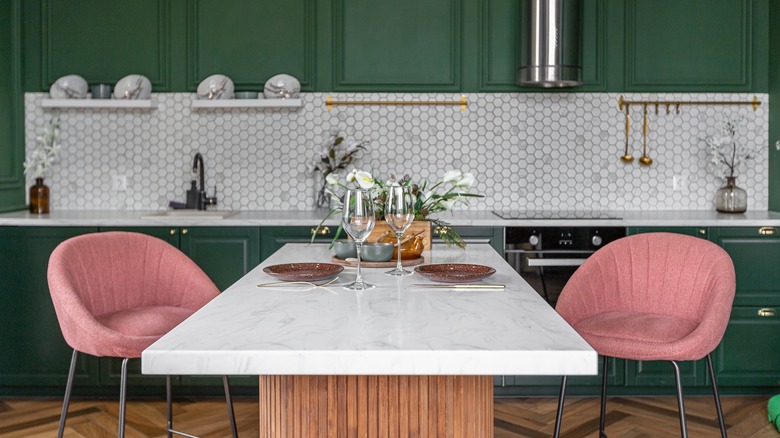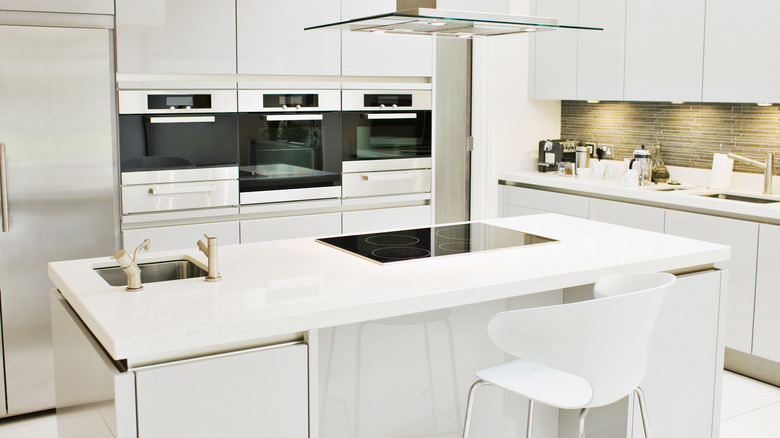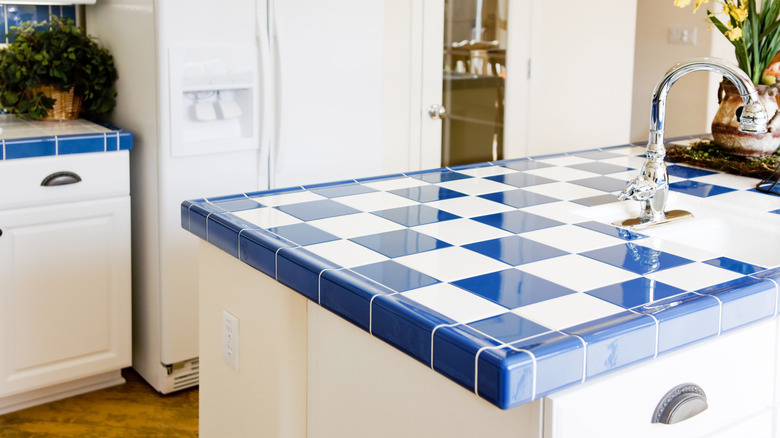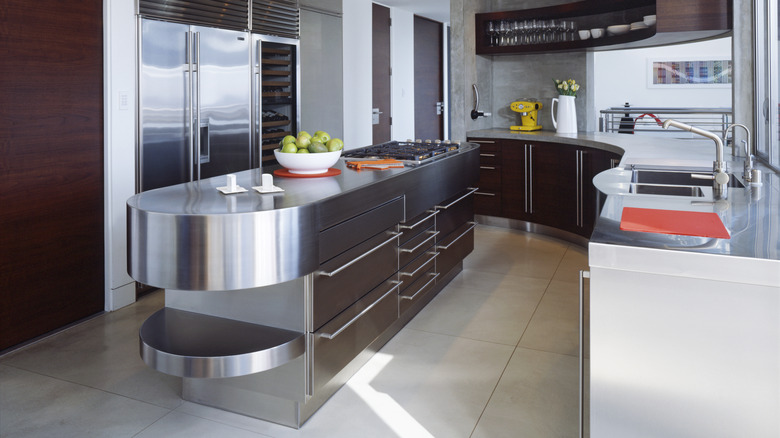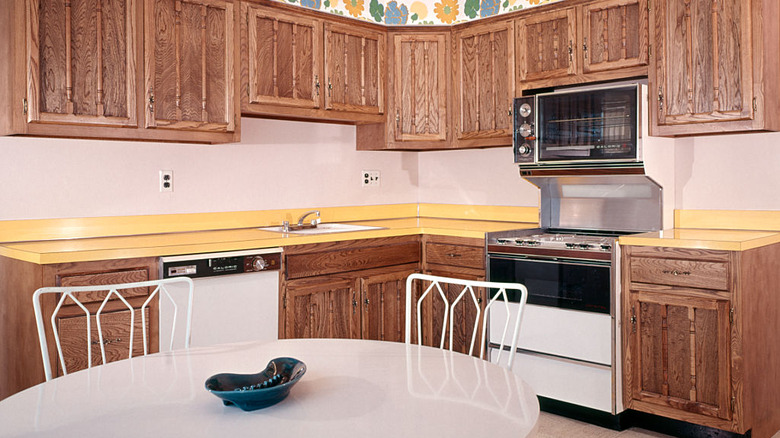8 Retro Kitchen Countertop Trends That Could Make A Comeback
When designing or remodeling your home kitchen, choosing the right countertop material is an important decision. You want something durable but not too boring, stylish but not overly trendy — something that speaks to you and reflects your personal taste. But which of the many available surfaces should you spring for?
There are seemingly endless choices to select from for your countertop commitment. The design world is filled with countless options, from engineered materials like contemporary glass to heat-resistant concrete. But perhaps these modern trends aren't for you. If that's the case, consider looking at the modes of the past and opting for a retro design that's sure to make a statement.
Forget the quartz versus granite debate. Let the masses have their costly quartzite and their boring granite slabs. You're looking for a countertop material that makes an impression. From vintage surfaces with a nostalgic quality to those with a timeless beauty, it's time to look at some countertop trends from the past that are due for a comeback.
'70s terrazzo
Terrazzo countertops were a bold trend of the 1970s, utilizing a mosaic-like design that originated in Italy. Brought to America by Italian immigrants, the material was first used in flooring before expanding to a kitchen countertop choice in the '50s and '60s. A technique that dates back hundreds of years to the Venetians, it began as an innovative way to use the leftover chips from marble slabs leading to stunning results.
A sturdy material that is durable and low-maintenance, terrazzo is fashioned from scraps of stone like marble, quartz, glass, and other materials set in a mixture of concrete or resin. Its appearance can be dazzling — somehow both contemporary and retro all at once. Classic designs often used cement and marble, implementing scrap materials to make a fashionable statement that was buffed to a glossy perfection.
In the modern kitchen, terrazzo countertops are often made from resin — a substance that is significantly less porous than cement. A retro trend ready for a comeback, this countertop choice has a beautiful artistic quality that can feel modern or organic depending on your color choices. Terrazzo can be paired with mixed metals, natural woods, and colors mirrored in the countertop, resulting in a design that is filled with character and pizazz.
Colonial soapstone
For those who prefer a more natural look, soapstone is another impressive countertop choice. A naturally-occurring material with a grayish, sometimes green coloring and striking white veins, this heat-resistant stone was a popular countertop choice in the Northeast U.S. where it was plentiful. A stone first discovered by indigenous people and used by American colonists in their fireplaces and sinks, this ageless material still stands in many of the historic homes of the original 13 colonies.
Soapstone countertops are ideal for those looking for a less glossy finish, given its matte appearance.They earn a patina as they age, acquiring a lived-in appearance that lends home kitchens an inherent warmth. This stunning stone looks wonderful alongside wood cabinets and stainless steel appliances. It can also be waxed or oiled to darken the color, heightening the contrast of the veining and protecting this softer surface.
A material that has risen and fallen in popularity over the decades, it continues to hold its own as an enduring element in kitchen design. This stone is naturally heat-resistant and less pricey than other stone surfaces. It's also highly stain-resistant due to its nonporous nature. The only downside? As a softer stone, it can chip more easily. Luckily, soapstone's softness also helps it, as pesky scratches can easily be sanded out. Unlike other stone surfaces, soapstone is also quite acid-resistant, making it an exceptional choice for bar tops that might see lemon juice and wine spills.
Wood surfaces
Wood was a common sight in late Victorian kitchens, especially unfitted kitchens, with butler's pantries often having wood surfaces to work on. Wood work tables, dough tables, and hoosier cabinets (a storage space with an extended work surface) were all elements in domestic kitchens of this era.
A homey trend with a cozy appeal, wood countertops have seen a resurgence as of late in the butcher block-style, with wood options including mesquite, maple, birch and other woods in a variety of styles. Teak, walnut, and cherrywood are also popular options, with teak being water-resistant, black walnut being naturally antibacterial, and cherrywood being known for its reddish hue.
Just be aware wood countertops do need to be regularly treated either with oil or wax. Wood counters can be sealed with linseed oil, mineral oil, hemp oil, carnauba wax, and beeswax — all which are food safe. Additionally, be sure to keep hot pans and water off your wood surfaces to keep their beauty intact.
An eco-friendly choice, wood surfaces can be used throughout a kitchen's counters surfaces or in a more limited fashion, via a freestanding work table or topping a floating island. Another benefit of wood counters? Unlike many other kitchen surfaces, wood countertops can be painted if you ever change your mind. However, given the lasting appeal of this nostalgic countertop, it's doubtful you ever will.
Classic marble
Marble has been a material prized for centuries, being first used by the ancient Greeks and Romans in monumental works of architecture and sculpture. A difficult to quarry stone, it was rarely used by anyone but the most wealthy in their homes. Marble became much more readily available to consumers following the industrial revolution, making cutting and transporting slabs much easier in the early 20th century. Although marble fell out of favor in the wake of laminate imitations, it holds a classic and timeless appeal well due for a renaissance.
Marble countertops hold a universal allure. Although marble may not be as durable as stone surfaces like granite, it carries an ageless elegance — one which will never go out of fashion. Marble is a long-lasting stone, which is why it has been used in works or art and architecture for centuries. It obtains a character as it ages that fits wonderfully with darker, cozier kitchen colors.
Still, it is best to keep these classic countertops away from acids like vinegar and lemon juice. As a carbonate, marble can react with these acidic substances; such liquids can damage the marble surface, leaving etches or dull areas. Other than this, marble is relatively simple to care for. All these grand countertops need are a little warm water and dish soap for cleaning.
All-white countertops
When you think of white-tile kitchens, many of us are instantly transported to the '80s and '90s. But strangely, the white kitchen tile aesthetic dates back long before this, having a strange and fascinating history. In 1918, a devastating flu epidemic spread throughout the United States with effects so wide sweeping as to even influence kitchen design. This spurred a sanitary-focused theme in kitchens and homes that continued well into the 1920s. As part of this movement, white subway tiles were often used on countertops, making any dirt or grime more noticeable and easily cleaned.
While all-white kitchens as were popular of that era can be overwhelming today, when paired with darker cabinets or vivid backsplashes, white countertops can provide a crisp look. They also don't have to be tiled, with white countertop options spanning from white quartz to porcelain. Whether warm white or cool white, lighter countertops are spectacular when complemented with a contrasting color, like deep wood tones or boldly painted cabinets.
Worried white countertops will look too sterile in your home? Warm whites like cream and ivory shades are far more cozy than cool-toned whites. Brass, bronze, and gold-colored metals can also warm up the space as can brightly painted walls.
Old-school ceramic tile
Ceramic tiles were a popular kitchen countertop material beginning the 1920s, as kitchens became spaces less used by servants and more occupied by women. Tiles in bright colors with tight grout lines were frequently seen, often featuring a hex or smaller square shape. But these weren't the all-white tiles that came before. A trend of vibrant hues began in the '20s, with tiles featuring multiple colors like blue and yellow or green with orange. A style that continued to evolve up into the 1940s, it makes a bold statement in the modern kitchen.
The ceramic tile trend did see a resurgence in the '80s, featuring everything from primary colors to floral designs, but vanished again in the wake of the early 2000s granite takeover. You might be surprised to hear, but tile kitchen countertops are indeed making a comeback as of recent. Unlike other surfaces, you don't have to worry about stains or acids eroding these materials. Yes, the grout lines can be a pain to clean, but visually, the effort can be worth it.
Ceramic tiles are less expensive than many stone countertops, and can make a striking impact. You can also extend the design upward into your backsplash for a seamless look that isn't nearly as costly as if you were to do so with stone. Colorful ceramic tiles can add a splash of nostalgia to your kitchen space, be they in a checkerboard pattern or as a pop of personality on a kitchen island, making for a kitchen that truly catches the eye.
Stainless steel and metal surfaces
Stainless steel is a relatively newer material in the kitchen world, having been invented in 1913 and refined in the following decades. It became a staple in commercial kitchens in the 1930s after SS Queen Mary featured the first stainless steel kitchen. Heralded for being durable and easy to clean, it soon became seen as a top-tier material in the culinary space.
Stainless steel later made its way into home kitchens in cabinetry and countertops following the economic boom of WWII, with its use as a countertop material continuing well into the '40s and '50s. A versatile material with an industrial edge, it's prime for a return to the home kitchen, having a retro appeal that is extremely durable. Stainless steel doesn't chip like stone or crack like tile. It is nonporous, meaning it won't stain or absorb liquids. It stands up against heat and is even recyclable should you ever decide to remove it.
When it comes to aesthetics, metallic countertops like stainless steel look spectacular in vintage kitchen designs, adding a functional yet unique quality to these spaces. But they don't have to look shiny and polished. You can install stainless steel counters that are pre-scratched or pre-sanded to give them a more lived-in feel— something which works well with more traditional, less-modern designs.
Mid-century laminate
Laminate countertops became available in the 1940s and '50s, following WWII. An affordable option that provided an array of colors and designs like starbursts and cracked ice, brands such as Formica and Wilsonart dominated the market for many decades. Many of these laminate countertops featured a metallic edging, adding an extra layer of texture to kitchen designs.
Ever wonder what this economical material actually made of? Mainly, laminate uses paper, soaking sheets of it in melamine resin which are then compressed together under high temperatures. Next topped with a decorative paper, it is cured in an oven and finally fixed to particle board. Despite what you might think, laminate is still alive and well in kitchen design. Both Formica and Wilsonart continue to provide updated laminate as an affordable option for contemporary consumers, with kitchen offerings spanning from wood grain-looks to vibrant vintage styles. Both brands have updated their product line of high-pressure laminate (HPL), which is far more durable than classic laminate, resisting scratches and wear.
One of the most budget-friendly countertops, laminate is a great choice for those unwilling to commit to pricier material, but who would still like the look of stainless steel, marble, or more expensive stones. However, for a truly retro effect, we recommend pairing these vintage counters with a shiny, metal trim along the edge, as was once popular in midcentury kitchens. You don't even need to use actual metal, but you can utilize a faux metallic laminate to achieve this carefully curated look.

